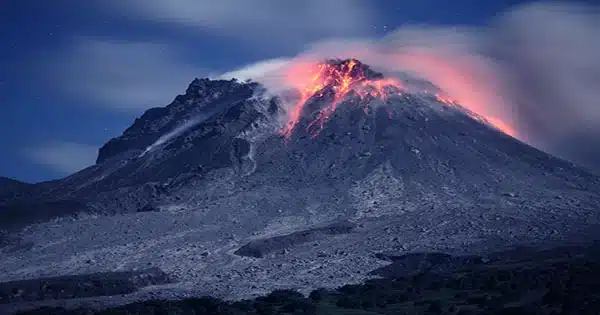Earth underwent a centuries-long widespread chilly era known as the Little Ice Age before people began warming the globe by burning fossil fuels in the 19th century.
Scientists speculate that volcanic eruptions that altered the atmosphere hazier and blocked some incoming sunlight may have contributed to this cold snap.
Since there are few records of these eruptions, most of what we know about them comes from fragmented and occasionally conflicting evidence in polar ice and tree rings.
An international research team at the University of Geneva, under the direction of Sébastien Guillet, has discovered another method for discovering information on these historical eruptions: reading accounts of lunar eclipses in medieval manuscripts. Their findings have just been published in Nature.
Dark eclipses: The researchers compiled hundreds of records of lunar eclipses from across Europe, the Middle East, and Asia, documenting 187 eclipses between 1100 and 1300.
They were looking for descriptions that included information on the brightness and color of the Moon during the eclipse. The majority of them were written in Latin by European monks or clergy.
The researchers graded the brightness and color of the Moon recorded during each total eclipse based on these descriptions. Darker eclipses revealed a more significant concentration of aerosol particles in the upper atmosphere, a sign of recent volcanic activity. The brighter the eclipse, the cleaner the atmosphere at the time.
The eclipse data was then combined with computer models of aerosol particle behavior in the atmosphere, recent satellite measurements, and climate data from ancient tree ring records.
In contrast to earlier ice core records, this allowed the researchers to estimate the culprit eruptions’ date with more accuracy. They were also able to identify which eruptions reached the stratosphere and were therefore more likely to result in climatic cooling.
What moon eclipses reveal about atmospheric conditions: It is stunning to witness a total moon eclipse. Our planet prevents the Moon’s surface from receiving direct sunlight when the Sun, Earth, and Moon are properly aligned.
However, sunlight is bent around our globe by the atmosphere. As a result, even during a complete eclipse, the Moon receives some sunlight.
Additionally, the atmosphere of Earth scatters sunlight, serving as a massive color filter. The sky is blue throughout the day and the Sun seems reddish at dawn and sunset because the light is dispersed more when it is bluer.
Lunar eclipses can provide important information about the state of the Earth’s atmosphere. During a lunar eclipse, the Earth’s atmosphere can scatter some of the sun’s light and bend it towards the moon. This light can then pass through the Earth’s atmosphere and get refracted, causing the moon to take on a reddish hue.
The exact color of the moon during a lunar eclipse can vary depending on the amount and type of particles in the Earth’s atmosphere. For example, if there are a lot of small particles in the atmosphere, such as from a recent volcanic eruption or wildfire, the moon may appear darker or even a deep red color. On the other hand, if the atmosphere is relatively clear, the moon may appear lighter or more orange in color.
Scientists can use the color of the moon during a lunar eclipse to study the Earth’s atmosphere and determine the number of particles in it. This information can be used to study phenomena such as air pollution, volcanic eruptions, and other events that can affect the Earth’s atmosphere. Additionally, studying lunar eclipses can help scientists understand the composition and behavior of the Earth’s atmosphere over time.
The sunlight reaching the Moon during a total lunar eclipse has been filtered by Earth’s atmosphere, reducing most of the blue and yellow light. The light reaching the Moon is basically the total of all the dawns and dusks that occur at that period.
And how much light is filtered depends on the state of the Earth’s atmosphere at the moment.
The Effect of Volcanoes on Lunar Eclipses: Volcanic eruptions can have an impact on lunar eclipses by affecting the Earth’s atmosphere. During a volcanic eruption, a large amount of volcanic ash and other particles can be thrown into the atmosphere. These particles can then be carried by the wind and spread over a wide area.
When there are a lot of particles in the atmosphere, they can scatter the sun’s light and cause the moon to appear darker during a lunar eclipse. This is because the particles in the atmosphere can absorb and scatter the shorter wavelengths of light, such as blue and green, while allowing the longer wavelengths, such as red and orange, to pass through. As a result, the moon can take on a darker or redder appearance during a lunar eclipse if there are a lot of volcanic particles in the atmosphere.
In addition to affecting the appearance of the moon during a lunar eclipse, volcanic eruptions can also have a more long-term impact on the Earth’s atmosphere. The particles and gases released during a volcanic eruption can remain in the atmosphere for months or even years, affecting climate patterns and air quality around the world. Scientists study the impact of volcanic eruptions on the Earth’s atmosphere through a variety of methods, including studying lunar eclipses.
An excellent example is the breathtaking volcanic sunsets that were seen all throughout Australia in the months that followed the Tongan volcano eruption in January 2022. Once in the stratosphere, the debris will disperse throughout the planet.
Does this affect lunar eclipses in any way? It turns out that the amount of stuff in our stratosphere affects the brightness of the Moon during a lunar eclipse. Any moon eclipse in the months after a major eruption would be noticeably darker than usual.
How volcanoes affect the climate: Volcanoes can have a significant impact on the Earth’s climate through the release of gases and particles into the atmosphere. When a volcano erupts, it releases large amounts of carbon dioxide, sulfur dioxide, and other gases into the atmosphere. Additionally, ash and other particles can be ejected into the upper atmosphere, where they can reflect sunlight back into space and cool the Earth’s surface.
The amount of climate impact from a volcanic eruption can vary depending on the size and duration of the eruption, as well as the location and type of volcano. Large, explosive eruptions can release huge amounts of gases and particles into the atmosphere, potentially cooling the Earth’s surface by several degrees for a period of years.
In addition to cooling the Earth’s surface, volcanic eruptions can also have other effects on the climate. For example, the release of sulfur dioxide into the atmosphere can combine with water vapor to form sulfuric acid, which can then form reflective particles in the atmosphere that can reduce the amount of sunlight reaching the Earth’s surface. This can lead to a cooling effect on the climate.
Scientists study the impact of volcanic eruptions on the climate through a variety of methods, including analyzing ice cores, tree rings, and other records of past climate. They also use computer models to simulate the effects of volcanic eruptions on the Earth’s climate. Understanding the impact of volcanoes on the climate is important for predicting and mitigating the effects of future volcanic eruptions, as well as for understanding natural climate variability.
The past and future of volcanoes, eclipses, and the climate: In the study of volcanoes, eyewitness testimonies from historical records and oral conventional knowledge are frequently ignored. To better comprehend the previous effects of volcanic eruptions on humans and the environment, however, larger sources of knowledge should be included.
Volcanoes, eclipses, and the climate are all interconnected in complex ways, and their past and future are shaped by a variety of factors. Here is some information on each topic:
Volcanoes:
- In the past, volcanic eruptions have had significant impacts on the climate, causing periods of cooling and even triggering mass extinctions. For example, the eruption of Mount Tambora in 1815 caused a “year without a summer” in parts of the Northern Hemisphere due to the amount of ash and gas released into the atmosphere.
- In the future, scientists predict that volcanic eruptions will continue to occur, and some may have significant impacts on the climate. However, advances in monitoring and prediction technology mean that we may be better able to prepare for and mitigate the effects of future eruptions.
Eclipses:
- Lunar and solar eclipses have been observed and studied for thousands of years, and they continue to be important astronomical events. They can provide information on the composition of the Earth’s atmosphere, the behavior of the sun and moon, and other topics.
- In the future, eclipses will continue to occur, and scientists will likely continue to study them using advanced technology such as telescopes, cameras, and satellites.
Climate:
- The Earth’s climate has undergone significant changes over its history, including periods of warming and cooling due to natural factors such as volcanic eruptions, changes in the Earth’s orbit, and variations in solar output.
- In the future, scientists predict that the Earth’s climate will continue to change, largely due to human activities such as the burning of fossil fuels and deforestation. This is expected to lead to rising temperatures, more frequent extreme weather events, and other impacts.
- However, there is also hope that we can mitigate the worst effects of climate change through efforts such as reducing greenhouse gas emissions, developing renewable energy sources, and protecting natural ecosystems.
Volcanoes might have to put in a bit more effort in the future to produce a “dark” eclipse. The stratosphere will rise in altitude as the climate warms. Therefore, a larger eruption could be required to deposit considerable amounts of aerosols in the top layer where they will persist and darken the Moon for future generations!















